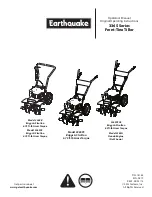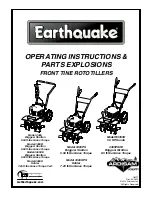
VOLTAGE
Main Power Supply — Minimum and maximum acceptable
supply voltages are listed in Tables 4A-4C.
Unbalanced 3-Phase Supply Voltage:
Never operate a motor where a phase imbalance between
phases is greater than 2%. To determine percentage of volt-
age imbalance:
max voltage deviation
from avg voltage
% Voltage Imbalance = 100 x
average voltage
The maximum voltage deviation is the largest difference
between a voltage measurement across 2 legs and the aver-
age across all 3 legs.
EXAMPLE: Supply voltage is 240-3-60.
AB = 243 v
BC = 236 v
AC = 238 v
243 + 236 + 238
Average voltage =
3
717
=
3
= 239 v
Determine maximum deviation from average voltage:
(AB) 243 − 239 = 4 v
(BC) 239 − 236 = 3 v
(AC) 239 − 238 = 1 v
Maximum deviation is 4 v.
Determine percentage of voltage imbalance:
4
% Voltage Imbalance = 100 x
239
= 1.7%
This voltage imbalance is satisfactory as it is below the
maximum allowable 2%.
IMPORTANT: If the supply voltage phase imbalance
is more than 2%, contact your local electric utility com-
pany immediately. Do not operate unit until imbalance
condition is corrected.
Control Circuit Power — Electronic control includes logic
to detect low control circuit voltage. Acceptable voltage range
is shown in Table 5.
MINIMUM FLUID LOOP VOLUME — To obtain proper
temperature control, loop fluid volume must be at least 3 gal
per ton (3.25 L per kW) of chiller nominal capacity for air
conditioning and at least 6 gal per ton (6.5 L per kW) for
process applications or systems that must operate in low am-
bients (below 32 F [0° C]). Refer to application information
in Product Data literature for details.
FLOW RATE REQUIREMENTS — Standard chillers should
be applied with nominal flow rates approximating those listed
in Table 12. Higher or lower flow rates are permissible to
obtain lower or higher temperature rises. Minimum flow rates
must be maintained or exceeded to assure turbulent flow and
proper heat transfer in the cooler.
Operation below minimum flow could subject tubes to
frost pinching in tube sheet, resulting in failure of cooler.
Consult application data and job design requirements to
determine flow rate requirements for particular installation.
Table 12 — Nominal and Minimum Cooler
Fluid Flow Rates
30GT
UNIT SIZE
NOMINAL FLOW
RATE*
MINIMUM FLOW
RATE
(See Notes)
Gpm
L/s
Gpm
L/s
080,230B
192
12.11
66.7
4.2
090,245B
216
13.62
66.7
4.2
100,255B,270B
240
15.14
84.1
5.3
110,290B,315B
264
16.65
84.1
5.3
130
300
18.9
110
6.9
150,230A,245A,
255A
348
21.9
110
6.9
170,270A,330,
360B (50 Hz)
384
24.2
120
7.5
190,290A,
360A/B (60 Hz),
360A (50 Hz),
390B
432
27.2
120
7.5
210,315A,390A,
420A/B
480
30.2
148
9.3
LEGEND
ARI
— Air Conditioning and Refrigeration Institute (U.S.A.)
Gpm — Gallons per minute (U.S.A.)
L/s
— Liters per second
N
— Liters per kW
V
— Gallons per ton
*Nominal flow rates required at ARI conditions 44 F (7 C) leav-
ing fluid temperature, 54 F (12 C) entering fluid temperature,
95 F (35 C) ambient. Fouling factor .00025 ft
2
•
hr
•
F/Btu
(.000044 m
2
•
K/W).
NOTES:
1. Minimum flow based on 1.0 fps (0.30 m/s) velocity in cooler with-
out special cooler baffling.
2. Minimum Loop Volumes:
Gallons = V x ARI Cap. (tons)
Liters
= N x ARI Cap. (kW)
APPLICATION
V
N
Normal Air Conditioning
3
3.25
Process Type Cooling
6 to 10
6.5 to 10.8
Low Ambient Unit Operation
6 to 10
6.5 to 10.8
Operation Sequence —
During unit off cycle, crank-
case heaters are energized. If ambient temperature is below
36 F (2 C), cooler heaters and a microprocessor board heater
are also energized.
When control ON-OFF switch is turned to ON posi-
tion, control first goes through a 2-minute initialization,
period, during which the display continuously shows
.
Ninety (90) seconds after
leaves display, control be-
gins to bring on compressors. Rate at which compressors are
started depends on leaving chilled fluid temperature and rate
of change of leaving fluid temperature.
An automatic lead-lag feature in control system on all units
determines by random selection whether circuit A or B starts
first.
At first call for cooling, microprocessor starts first com-
pressor, deenergizes crankcase heater, and starts one con-
denser fan.
51
















































